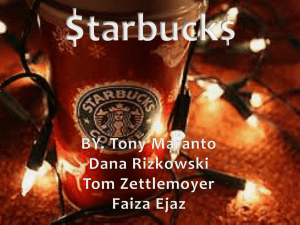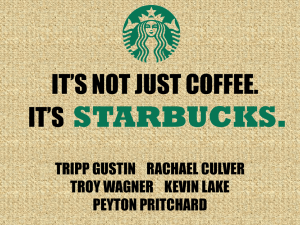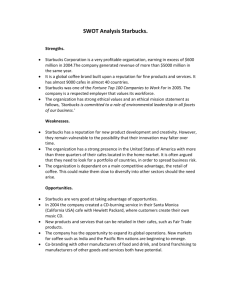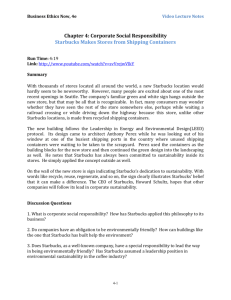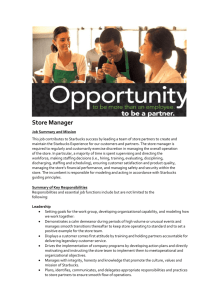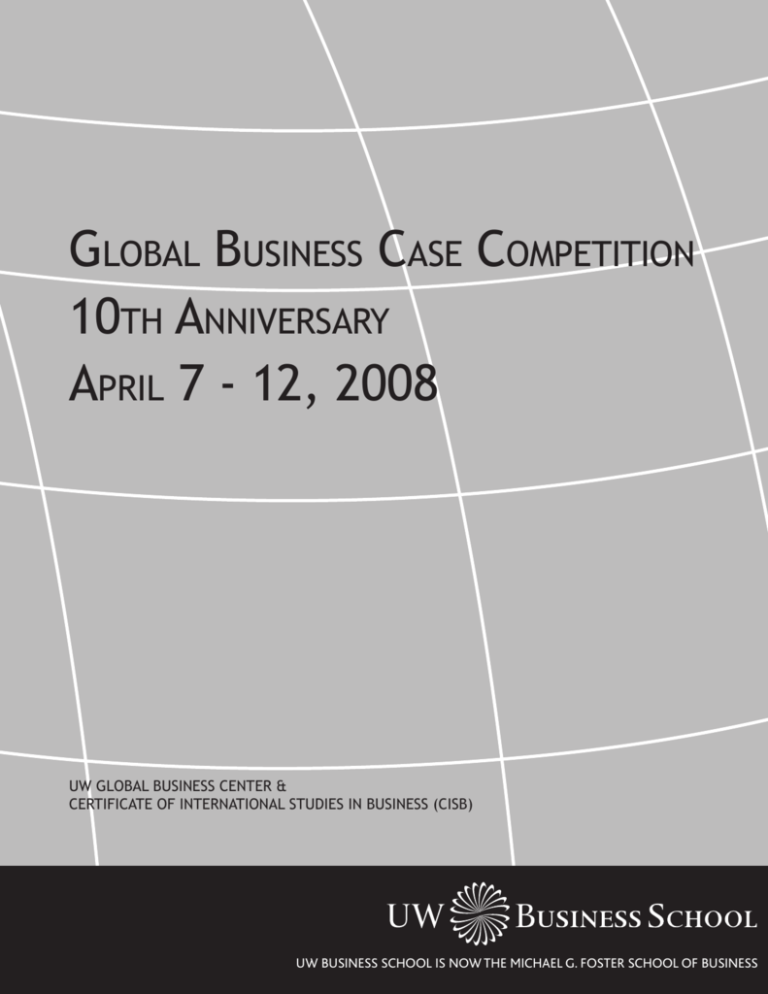
Global Business Case Competition
10th Anniversary
April 7 - 12, 2008
UW GLOBAL BUSINESS CENTER &
CERTIFICATE OF INTERNATIONAL STUDIES IN BUSINESS (CISB)
UW BUSINESS SCHOOL IS NOW THE MICHAEL G. FOSTER SCHOOL OF BUSINESS
Starbucks Entertainment: Global Delivery of Music
Starbucks Coffee Company has a globally-recognized brand and an impressive
record of growth, with an ever-increasing number of stores both in and outside the United
States. However, in 2008, the company faces some new challenges. A slowdown in
customers’ visit frequency to US stores in 2007 is prompting big changes. The
company’s response includes a shake-up of management and a re-focus on coffee. With
Howard Schultz returning to the position of CEO and president, in addition to chairman,
Starbucks has decided to slow down the pace of domestic expansion while maintaining
the pace of expansion outside the U.S.
Starbucks not only sells coffee but also products that enhance the coffee
experience. Since 1999, the company has been selling music CDs in its stores. In 2004,
a separate business unit, Starbucks Entertainment, was created, and three years later it
launched its own music label, Hear Music™. More recently, Starbucks has branched out
into digital downloads.
Where does the Starbucks Entertainment music business fit into the plan to reinvigorate Starbucks? In particular, how can Starbucks Entertainment grow its music
business internationally?
Starbucks domestic and international growth
From its first store, established in 1971 in the Pike Place Market in Seattle,
Starbucks has grown to over 15,000 stores in 45 countries. 1 Currently the company has
more than 200,000 employees (“partners”) worldwide. Starbucks has a long term goal of
40,000 stores – 20,000 in the U.S. and 20,000 outside the U.S. Exhibit 1 lists the foreign
locations where Starbucks has stores as of April, 2008. See Exhibit 2 for domestic and
international store numbers.
Starbucks has three reportable operating segments: United States, International
and Consumer Products Group (CPG). 2 The United States and International segments
consist primarily of retail stores. The CPG segment includes Starbucks grocery business
as well as branded products sold globally. Exhibit 3 presents revenue by segment, and
Exhibit 4 presents revenue components. The Starbucks Entertainment business unit does
not report separately; it is included in Specialty/Other Initiatives.
1
For a detailed company timeline, see http://www.starbucks.com/aboutus/company_timeline.pdf .
The following descriptions of Starbucks reportable segments for income are taken largely from the
company’s 2007 10K (for the year ended September 30, 2007) and the 10Q (for the quarter ended
December 30, 2007) filed with the SEC.
2
This case was written for the 2008 Global Business Case Competition by Helen Adams, Lecturer, and Debra Glassman,
Senior Lecturer, both from the Michael G. Foster School of Business at the University of Washington. It is intended to
serve as a basis for student analysis rather than to illustrate either effective or ineffective handling of an administrative
situation. Special thanks to Herman Uscategui for his support of this project and Beth Tallman for her industry insights.
Copyright © Adams & Glassman, 2008. All rights reserved.
The United States segment has over 11,000 stores and generates over 75% of total
revenues. Since Starbucks has been operating much longer in the U.S. than
internationally, the brand is more mature in the U.S. market and average sales per store
are higher. In addition, certain costs are lower in the U.S., so this segment has a higher
operating margin.
Many of Starbucks international operations are still in the early stages of
development and require more extensive support. But the international store base is
growing rapidly, and it is making an increasing contribution to total revenue. (See
Exhibit 5.) The growth includes both expansion in established international markets and
entry into new ones, including emerging markets such as China. The mode of market
entry differs by country. Sometimes Starbucks owns and operates the stores (as in, for
example, the UK, Germany and Singapore), but many international markets are entered
with a partner, either via a joint venture or by licensing. Expansion continues in 2008.
The company opened its first store in the Czech Republic in January and has announced
plans to enter two additional markets, Bulgaria and Portugal, later in the year.
From the beginning, Starbucks was not just about coffee. The three founders -English teacher Jerry Baldwin, history teacher Zev Siegel, and writer Gordon Bowker -derived the store's name from a Moby Dick character, Starbuck. Starbucks had a vision
of the coffeehouse as a “third place” between work and home. The design of the stores,
the products and the atmosphere all had to contribute to the coffeehouse experience. The
current CEO, Howard Schultz, still talks about this vision. 3
Recent challenges and Starbucks responses
In 2007, Starbucks U.S. sales slowed. The fourth quarter of fiscal 2007 was the
first time that Starbucks experienced a decrease in the average number of transactions per
store. The stock price fell sharply, and analysts began criticizing the company. They
suggested that too-rapid domestic expansion had led to over-saturation, that business
would be lost to cheaper competitors like McDonalds, and that Starbucks stores had lost
their coffeehouse aura.
On January 7, 2008, Starbucks announced that its chairman, Howard Schultz,
would take on the additional role of president and chief executive officer, replacing Jim
Donald who left the company. Schultz had previously served as CEO from 1985 to 2000.
Schultz has launched a “transformation agenda,” the cornerstone of which is a
renewed focus on the “coffee experience.” According to the company,
Over the coming months, management will focus on building a long-term model
to realize a transformation agenda and drive long-term shareholder value. This
agenda includes particular focus on delivering what customers want and expect,
and providing the Company’s partners with the tools to help them exceed
customers’ expectations. It is expected that this focus will enable the Company to
3
Joe Nocera, “A Double Shot of Nostalgia for Starbucks,” New York Times, March 3, 2007.
Starbucks Entertainment Page
2
offer a renewed Starbucks Experience to customers, while systematically building
the foundation for strong, sustainable growth in fiscal 2009 and beyond. 4
Schultz’s new strategy also includes slowing Starbucks expansion in the U.S. and
accelerating expansion outside the U.S. Instead of opening 1,600 U.S. stores in fiscal
2008, Starbucks plans to open 1,175. Internationally, the target is 975 net store openings,
up from 783 store openings in fiscal 2007. These numbers are aggregates for companyoperated retail stores and licensed retail store operations. 5 See Exhibit 6 for a summary
of the transformation plan.
Some aspects of the plan involve forgoing revenue-generating activities in order
to focus on the coffee. For example, the company decided to stop offering certain food
items, and, on February 26, all U.S. stores were closed for three hours for a training
session. The transformation activities have generated a lot of press, such as this item
from February, 2008:
In the month since chief executive officer Howard Schultz unveiled plans for
regaining the buzz, he's discontinued warmed breakfast sandwiches (the smell
interferes with the coffee aroma that customers love), slowed new store openings
and reorganized operations.
And now, he's closing stores for training that he promises will re-energize
baristas and enhance the customer experience. Translation: Baristas will
learn how to pull the perfect shot again and steam milk to order, not just
press a button on the automatic espresso machine 6 .
Starbucks Entertainment and the music industry
The Starbucks experience has long included music. The music idea came from
Timothy Jones, who was the Starbucks store manager in the University Village (a
shopping mall near the University of Washington). Jones had owned a record store in the
University District in Seattle. When he closed the store, he went to work at Starbucks. In
1995 he started playing his favorite music there and customers asked about it. This
eventually led to the sale of music compact discs (CDs) in Starbucks stores. Today Jones
is part of Starbucks Entertainment’s content team.
In 1999, Starbucks bought a small company called Hear Music that was started by
a college student who created music compilations. Hear Music asked musicians to
identify the work of other artists that influenced them and made compilations of them.
The first compilation was “Blue Note.”
4
From the 10Q filed with the SEC in February, 2008 for the quarter ended December 30, 2007.
Ibid.
6
Elizabeth Lee, “Starbucks takes a coffee break to train,” The Atlanta Journal-Constitution,
February 26, 2008.
5
Starbucks Entertainment Page
3
The Starbucks Entertainment business unit was created in 2004, and Ken
Lombard was hired as its president. 7 Lombard, a former University of Washington
basketball player, was the president of Johnson Development Corporation/Magic Johnson
Theatres, a company created by basketball great Earvin “Magic” Johnson to generate
retail development in underserved parts of U.S. cities. The joint ventures that Lombard
negotiated with retailers like Starbucks and with the entertainment industry ultimately led
to his job at Starbucks Entertainment.
Music was a good fit with the coffeehouse atmosphere of Starbucks stores, and
Starbucks Entertainment aimed to support coffee sales. Lombard said, "Music has
always been part of the Starbucks experience.... And now our customers will have more
reason to come and stay longer. The longer they stay, the more they buy." 8
In 2004, Hear Music collaborated with Concord Records to release the Ray
Charles CD, “Genius Loves Company.” The CD won 8 Grammy® Awards and sold
more than three million units worldwide. One quarter of those sales were in Starbucks
stores.
Meanwhile, the music industry itself was changing. The industry underwent a
number of major format changes over the previous fifty years – from vinyl records to
tape and then to compact discs. These changes were accompanied by changes in profit
margins. Vinyl records and cassette tapes had gross profit margins of around 42%, but
CD albums have gross profit margins of around 35%. The advent of digital music
formats is altering the industry again. And with it comes another assault on gross profit
margins.
Furthermore, the retail landscape has changed. Vinyl records were initially sold
by independent music stores, but later were supplemented by national chains like Tower
Records. In the CD era, record sales in the U.S. were increasingly made at “big box”
retailers like Wal-Mart, Target and Best Buy and also through online retailers like
Amazon.
In the words of Beth Tallman of EMT Consulting, and VP of a record company in
New York: “The industry is the wild west again.” 9
The Starbucks music-retail phenomenon comes at an interesting moment in the
recording industry… Traditional music retailers have become more selective with
their musical choices: These days, there are fewer music CDs, and more filmrelated DVD and computer-game products in stores. Meanwhile, grocery stores,
clothing outlets, department stores, restaurants and even drugstores have jumped
in to sell music - often at discounted prices…
7
Starbucks Entertainment (www.hearmusic.com) offers music, movie DVDs, and books. The focus in this
case is on music products.
8
Ann Brown, “What’s Brewing at Starbucks,” Black Enterprise, Volume 35, Issue 1, August 2004, p.25.
9
Interview with Beth Tallman, March 14, 2008.
Starbucks Entertainment Page
4
"What we saw was the chaos and the confusion the industry was experiencing,"
says [Ken] Lombard. "We felt we were perfectly positioned to provide a quality
retail experience." 10
Starbucks has experimented with different forms of music delivery. It sells CDs,
has offered CD-burning in selected stores and now has a partnership with Apple to
provide direct downloads from iTunes. In the world of physical CDs, there is a lot of
price differentiation among retailers. Starbucks is able to charge premium prices because
of their unique retail environment and customer base.
Ray Charles' "Genius Loves Company" is a hot seller -- at your local Starbucks,
that is. In fact, the ubiquitous coffee merchant says it has sold more of the late
singer's final compact disc than any music retailer, despite charging a steep
$15.99…
"We'll enhance the Starbucks experience while developing a new revenue
channel," Starbucks Entertainment President Ken Lombard said in a conference
call with Wall Street analysts. "Our customers have told us they want a new way
to buy music. They've lost touch with record stores and want music beyond the
Top 40 that they're currently exposed to."…
Take Ray Charles' "Genius Loves Company," which is doing better at Starbucks
than at many stores selling it for $9.99. A Sarah McLachlan CD last spring also
sold "phenomenally well" at Starbucks, another illustration of how adult
consumers who have fallen out of the habit of buying music find it convenient to
do so at Starbucks.
Indeed, the coffee-seller said it decided to delve into the record business because
of sea changes in the music industry -- a "perfect storm" in Starbucks' eyes. Best
Buy Co. became the first national retailer to disregard the suggested retail selling
price, marketing music as a $9.99 loss leader to lure shoppers into the store in
hopes they would buy televisions and other big-ticket goods. Other retailers
followed suit. That led to a devaluation of music and the homogenization of how it
was sold…
Starbucks says those forces have fractured the traditional music industry and
diminished the sense of discovery many consumers used to feel about music,
giving nontraditional retailers an "in" to capture those consumers. 11
With its thousands of stores, Starbucks has the biggest retail distribution network
in the music industry. However, Starbucks insists that the focus remain on coffee.
10
Larry LeBlanc, “Make mine a low-fat latte with a shot of Joni,” The Globe and Mail, September 22,
2007.
11
Becky Yerak, “Merchants range far beyond their staples,” Knight Ridder Tribune News Service,
November 11, 2004.
Starbucks Entertainment Page
5
Lombard says, “We never want the customer to feel that Starbucks has turned into a
music store.” 12
In 2007, Starbucks Entertainment created the Hear Music™ label in partnership
with the Concord Music Group. Glen Barros, president of Concord, said that Starbucks
“built-in audience” would be attractive to recording artists. "This is a pretty powerful new
platform, when you can reach 44 million customers per week through Starbucks
stores." 13
The first CD released by the Hear Music™ label was Sir Paul McCartney’s
“Memory Almost Full.”
"We got a call saying that Paul McCartney was interested in talking to us," said
Ken Lombard, president of Starbucks Entertainment, "and after we picked
ourselves up off the floor, we met with him in London and had a pretty in-depth
conversation about who we are as a company and about our commitment to
music." He added that the company told McCartney it could "bring more
exposure to this album than to other projects he's done." 14
Sir Paul said he was impressed by the idea of selling the album in thousands of Starbucks
retail stores: "For me, the great thing is the commitment and the passion and the love of
music, which as an artist is good to see." 15 Starbucks promoted the album by playing it
non-stop in all its stores on the day it was released. Of the first 447,000 copies sold, 45
percent were sold in Starbucks stores.
The philosophy underlying Starbucks Entertainment is to be selective, to act as
what is variously called a “filter,” an “editor,” or a “curator” for Starbucks customers.
These customers do not go to Starbucks to buy music; it is an impulse purchase.
Sometimes the purchase is motivated by the “overhead music” playing in the store. This
can be chosen by the store partners (employees), and thus can be highly localized. 16 To
encourage customer awareness, Starbucks has been installing flat screens in selected U.S.
stores to display information about the music currently playing.
Martin Coles, Starbucks chief operating officer, notes that, “The intention is not
to be a music company. Rather, the customer has given us permission to make some
suggestions about music.” 17
In a February, 2008 interview, Howard Schultz talked about Starbucks as a filter
and the interaction between music and the coffee business:
12
Interview with Ken Lombard, August 7, 2007.
BBC News, “McCartney Joins Starbucks Label,” March 22, 2007,
http://news.bbc.co.uk/go/pr/fr/-/2/hi/entertainment/6476843.stm .
14
Allan Kozinn, “McCartney plumbs ghosts and memories,” International Herald Tribune, June 5, 2007.
15
BBC News, op cit.
16
For example, there is a Starbucks store in Laguna Beach, California that is known for playing mostly
reggae music.
17
Interview with Martin Coles, December 11, 2007.
13
Starbucks Entertainment Page
6
I never imagined, honestly, that it would evolve to a point where we would be
selling music, downloading music in our stores with Apple, producing records,
and have the kind of influence that we've had, but I think it speaks to the trust that
our customers have come to expect from us. And I think the entertainment group
has done a fantastic job of being a curator of the kind of music that spans many
different genres but in a way has a sensibility that has been able to attract such
loyal customers. So as we go forward, I think it's an important component, but it's
important to state very clearly that we're a coffee company and we're not an
entertainment company, that entertainment is part of the strategy that enhances
the experience… 18
Tallman observes that, “Starbucks is a great filter – you know that the music will be
good”. 19
Chris Bruzzo, Starbucks chief technology officer, sees filtering as part of a
broader trend:
Starbucks doesn’t have to be everything to everybody. It can be an editor, have a
point of view. Customers today need a trusted editor to be a filter. In the
entertainment industry, the traditional filters (such as television networks) have
far less control today.
This [being a trusted filter] is the next big thing on the internet. Web 1.0 was
about ubiquity. Web 2.0 was about community. Web 3.0 will be about bringing
meaning to the internet. 20
Over time, the music selection process changed so as to appeal to a large enough
audience to generate sales volume. Ken Lombard explains:
Starbucks music side had an early reputation for being very eclectic and very
selective. But, to draw people beyond the core Hear Music™ customers, we had
to provide a much broader range [of product]. We still have a continued
commitment to great music opportunities that are unique and compelling and that
customers would not be aware of without us. But, to draw people beyond the core
Hear Music™ customers, we had to provide a much broader range [of product].
This is a shift from pre-2004. 21
Starbucks music sales in North America have continued to impress. According to
Billboard magazine:
While Starbucks may be facing some healthy competition on the coffee front, it
remains one of the most powerful music retailers in the market, even though it
carries only a handful of titles and sells new discs for top dollar…
18
Douglas Wolk, “The Billboard Q&A: Starbucks’ Howard Schultz,” Billboard, February 16, 2008.
Interview, op cit.
20
Interview with Chris Bruzzo, March 25, 2008.
21
Interview, op cit.
19
Starbucks Entertainment Page
7
Glen Barros, president/CEO of Starbucks' Hear Music™ partner Concord Music
Group, notes that Starbucks’ limited choice of titles is part of both companies'
strategy of selling to older music buyers who still purchase CDs. "We've always
focused on the adult music audience," Barros says. "Music is still an important
part of who they are, but there are other priorities that come first. To reach that
adult consumer, you have to make it easy for them to make the decision of what to
buy, and you have to make it easy for them to get."…
In the past few years, Starbucks has managed to avoid the price wars and loss
leaders that have pummeled the profit margins of nearly every other kind of
physical music retailer… 22
Starbucks Entertainment’s successes have been good for recording artists and the music
industry more generally:
"The Starbucks deal," says Toronto-based entertainment lawyer Susan
Abramovitch, "is the Holy Grail for artists right now." Indeed, for a recording
industry in the throes of a sickness that may well be terminal, Starbucks - which
sold an estimated 3.6 million albums in North America in 2006 - offers a
distribution channel that might become one of the music industry's most important
lifelines.
"What they do is brilliant, and they are amazing marketers," says Vancouverbased Terry McBride, president of Nettwerk Group, and manager of Avril
Lavigne and Sarah McLachlan…
"A lot of the major labels have been floundering a bit, and it's shown in some of
their results," noted [Paul] McCartney this past April, in the U.S. music-trade
publication Billboard. "You don't want to stay in a gang of mates who don't know
where they're going. I'd rather have people who say, 'We're going there.' And you
know what, it's worked. Starbucks are really keen." 23
While Starbucks is seen as providing successful marketing for an ailing recording
industry, some have criticized Starbucks Entertainment for becoming too mainstream in
its “editing” or “filtering.” A March, 2008 article in the New York Times claims:
The ardor for Starbucks has gone the way of yesterday morning's grounds. Critics
in the music industry say the company squandered its cachet by mismanaging the
effort to broaden its music mix. The choices that reflect its early taste for the
offbeat -- like an album from Lizz Wright, a torchy pop singer -- are now squeezed
in with offerings not unlike those at Wal-Mart, including the latest releases from
Alicia Keys and James Blunt… 24
22
Douglas Wolk, “Something’s Brewing: Starbuck’s Entertainment Play,” Billboard, February 16, 2008.
Larry LeBlanc, “Make mine a low-fat latte with a shot of Joni,” The Globe and Mail, September 22,
2007.
24
Jeff Leeds, “Does this Latte Have a Funny Mainstream Taste to You?” New York Times, March 17, 2008.
23
Starbucks Entertainment Page
8
Digital music – can it be profitable?
One thing is clear in 2008: physical music sales have collapsed. Digital sales are
growing (see Exhibit 7), but digital revenues do not completely make up for the decrease
in CD sales. 25 Similar trends are apparent worldwide. 26
With the world’s biggest wi-fi network, Starbucks is well-positioned to offer
music digitally. Lombard comments:
As you look at where the music business is going, you can see the shift from
physical CDs to digital. Probably digital won’t take over completely. How do
you predict what the balance will end up being?
Starbucks wants to offer both physical product and also world class digital. We
can’t over-invest in physical, in case the balance shifts more towards digital. 27
In September 2007, Starbucks and Apple reached a strategic partnership
agreement to make the Hear Music™ catalog available in a dedicated area of the iTunes
store and to give Starbucks customers access to 2 million iTunes songs.
Each time an owner of an iPhone, or new iPod Touch enters a Starbucks, a button
will appear on their device that enables them to buy music from the Wi-Fi library.
They can download a song--without having to log in--by whatever artist
Starbucks is featuring at the time, or music playing on the store's sound system or
any other they can find in the library. 28
Chris Bruzzo describes it this way: “This is about being able to get music where you are
inspired by it.” 29
The digital revolution means that the world is changing for recording artists,
record companies and retailers. Record labels spend considerable amounts, varying from
artist to artist, to produce and promote albums and they reap the profits if these costs
were covered.
The big four music companies in the world are the Universal Music Group, Sony
BMG Music Entertainment, Warner Music Group, and EMI Group. Each of these
companies in turn owns many smaller labels. For example, the EMI Group distributes
music products through the labels Capitol, EMI Records, and Virgin. There are also
25
Detailed sales data for the U.S. are provided by the Recording Industry Association of America at
www.riaa.com .
26
See http://www.ifpi.com/content/library/MUSIC-MARKET-DATA-2007.pdf .
27
Interview, op cit.
28
http://www.apple.com/pr/library/2007/09/05starbucks.html
29
Interview, op cit.
Starbucks Entertainment Page
9
many independent record companies, such as Concord and V2. 30 Often a smaller
company distributes its products through a larger one.
The economics of music products can be rather complex. As a starting point,
consider the traditional CD. On average, the cost to produce a CD is around $5.50 - $6;
this includes royalties and physical costs. Royalties for well-known artists can drive the
cost higher. Often there is a distribution fee on a sliding scale up to around $2.65.
Retailers then mark the CD up about 50%, to a typical price of $13.99. 31
Note that Starbucks realizes a larger profit on CDs than the average record
company. In some cases, Starbucks, with their label Hear Music™, is the producer of
music, as with Paul McCartney’s “Memory Almost Full.” Starbucks also provides its
own distribution and serves as the retailer (with minimal marketing costs).
With the advent of digital music, large servers store the music once it is produced,
and the cost of selling it is minimal. The standard retail price to download a song has
become 99¢; a whole album is about $10. This leaves little scope for the profit margins
that record labels had become accustomed to on a per unit basis.
This isn't great news for the record labels… Things will be miserable for them
until they concoct new ways to sell tunes, and those won't be as lucrative as the
old ways. That's why a number of artists are abandoning traditional labels to sign
with companies that have other agendas than selling music. Paul McCartney now
records for Starbucks. Madonna-nothing if not a barometer for where the
business is going-has inked a 10-year recording contract with concert giant
LiveNation… in a sense, it's irrelevant to argue what music is worth. Technology
wants to make it close to free. 32
Chris Bruzzo says, “One of the big business challenges around digital is the economics.
How do you maintain your profit margin? There’s not a lot of margin in a 99¢ download.
In this ‘a la carte’ model, you need a lot of volume.” 33
Financial details of the deal between Apple and Starbucks are proprietary. For
present purposes, one can speculate that, when Apple sells a Hear Music™ song (or one
from another record producer) on iTunes, they pay the label something like $.65 per
song. Furthermore, one can assume that Starbucks has an affiliate relationship with
Apple and receives a “commission” reflecting the business they steer to iTunes from their
highly desirable customer demographic.
30
For a more extensive list, see http://www.ifpi.com/content/section_links/member_sites.html . A range of
independent labels is described in “State of Indies: An indie who’s who,” Music Week, January 27, 2007.
31
An undated pie chart showing another breakdown of CD costs can be found at
http://www.cnn.com/interactive/entertainment/0101/cd.price/frameset.exclude.html .
32
Steven Levy, “How Much Is Music Worth?” Newsweek, October 29, 2007.
33
Interview, op cit.
Starbucks Entertainment Page 10
Since there are still customers in older age groups who have not yet totally
embraced downloads, Starbucks Entertainment is trying iTunes album cards as a
“bridging product” between CDs and digital downloads. Titles are selected (filtered) by
Starbucks and a plastic card, about CD size, is made. When the “album” is purchased at a
Starbucks store, a code on the card is activated to enable downloading from iTunes. The
John Lennon album, for example, has some bonus tracks and also has video to
differentiate it from a typical iTunes album. It retails for $24.95. The cards cost perhaps
$.25 each to produce, so inventory costs are minimal.
The music industry is wrestling within itself over how the meager per unit profits
on digital products should be split among producers, artists, and digital media. Looming
over the whole argument is the big concern about digital media piracy. In the U.S., music
producers want the royalties they pay to be reduced to 8% of wholesale revenues from
9%. (This royalty is usually split between the publishers and the songwriter.) Digital
media want the royalty rate lowered even further, to around 4% on downloads. They
argue that higher royalty rates worsen the piracy problem.
Global delivery of music
Starbucks Entertainment does not presently have a significant business outside the
U.S., aside from some limited CD sales (primarily in the UK, Japan, and Canada). The
next step is a broader international roll-out of music sales. Ken Lombard observes:
The international opportunity is there, but internationally we are where we were
in the U.S. three years ago.
Do we have the same ability to select relevant music internationally as
domestically? Probably yes – content people are pretty easy to find.
But there are a lot of challenges. For example, how do we get mindshare of the
baristas? In terms of pricing, there is a challenge – most labels are set up so that
the international group makes its own decisions. 34
Herman Uscategui, director of International Business Development for Starbucks, adds:
The brand is well established internationally, so now we don’t have to wait to get
to the music business. The music business is international from the starting line.
The Sergio Mendes and Herbie Hancock CDs were global launches. In fact, the
Herbie Hancock CD was the first global launch of any Starbucks product.
But there are complications in international expansion. There’s the localization of
music preferences and distribution channels. Intellectual property is so complex.
We are not doing anything major in China with music because of piracy and
34
Interview, op cit.
Starbucks Entertainment Page 11
regulations. The Ray Charles CD was being sold in the Forbidden City before it
was even released! 35
Starbucks Entertainment is just beginning to look at how to create an international
digital strategy. Chris Bruzzo notes:
Some relationships with customers around the Starbucks brand can only occur
once the brand is established and mature...
Music is a highly local phenomenon. It is localized by country and maybe also by
region. Not only is music local, but technology is local, and so is the store
experience. While Starbucks is a coffee store and not a music store, the music
does have to add to the Starbucks experience and to the bottom line in some
sense.
The progression to digital is different in the U.S. and the rest of the world.
Should the international strategy skip physical CDs? Is going straight to digital
the right strategy? 36
Chris Bruzzo also distinguishes among three kinds of products that might be
offered internationally. The first one is music by artists that have global appeal, such as
Paul McCartney. The second is more locally relevant music. An example might be
working with Japanese partners to identify music to offer in Japan. The third is at a
micro level, by store. Just as there is the “art wall” program in Starbucks stores, where
local visual art is displayed, local musical artists could also be played in certain stores.
This micro-level approach would help make Starbucks a relevant part of the local
community.
In mid-2008, Starbucks faces a number of questions about its international music
strategy. How can the Starbucks Entertainment unit contribute to the Starbucks bottom
line? How can international customers’ store experiences be enhanced by music while
still maintaining the core focus on coffee? What music products should be sold
internationally, and how should they be sold? How much money can Starbucks expect to
make in the next five years from offering music internationally?
35
36
Interview with Herman Uscategui, August 7, 2007.
Interview, op cit.
Starbucks Entertainment Page 12
Exhibit 1: Worldwide locations of Starbucks stores as of April, 2008
Australia
Austria
Bahamas
Bahrain
Brazil
Canada
Chile
China
China – Hong Kong, Macau S.A.R.
Cyprus
Czech Republic
Denmark
Egypt
France
Germany
Greece
Indonesia
Ireland
Japan
Jordan
Kuwait
Lebanon
Malaysia
Mexico
Netherlands
New Zealand
Oman
Peru
Philippines
Puerto Rico
Qatar
Romania
Russia
Saudi Arabia
Singapore
South Korea
Spain
Switzerland
Taiwan
Thailand
Turkey
United Arab Emirates
United Kingdom
United States
Starbucks Entertainment Page 13
Exhibit 2: Breakdown of stores by type and location
Number of stores
open as of
December 31, 2007
Number of stores
open as of
December 31, 2006
7,087
4,081
11,168
6,010
3,391
9,401
1,796
2,792
4,588
15,756
1,511
2,256
3,767
13,168
United States:
Company-operated stores
Licensed stores
Total US
International:
Company-operated stores
Licensed stores
Total international
Total stores
Source: SEC 10Q filing for quarter ending December 30, 2007
Exhibit 3: Fiscal 2007 revenue by segment (in thousands)
Unallocated
United States
International
Global CPG
Corporate
Total
Fiscal 2007:
Net Revenues:
Company-operated retail
$
6,560,864
$ 1,437,401
$
—
$
—
$
7,998,265
Licensing
439,161
220,832
366,345
—
1,026,338
Foodservice and other
348,968
37,926
—
—
386,894
Total specialty
788,129
258,758
366,345
—
1,413,232
7,348,993
1,696,159
366,345
—
9,411,497
Specialty:
Total net revenues
Source: SEC 10K filing
Starbucks Entertainment Page 14
Exhibit 4: Fiscal 2007 revenue components
Revenues
% of Total
% of Specialty
Net Revenues
Revenues
Company-operated retail
Specialty:
Licensing:
Retail stores
Grocery and warehouse club
Branded products
Total licensing
Foodservice and other:
Foodservice
Other initiatives (includes Starbucks Entertainment)
Total foodservice and other
Total specialty
Total net revenues
85%
7%
3%
1%
11%
47%
23%
3%
73%
4%
<1%
4%
15%
100%
26%
1%
27%
100%
Source: SEC 10K filing
Exhibit 5: Fiscal 2007 store information
As of and for the Fiscal Year Ended(1)
STORE INFORMATION
Percentage change in comparable store
sales
United States
International
Consolidated
Stores opened during the year:
United States
Sept 30,
2007
Oct 1,
2006
Oct 2,
2005
Oct 3,
2004
Sept 28,
2003
(52 Wks)
(52 Wks)
(52 Wks)
(53 Wks)
(52 Wks)
4%
7%
5%
7%
8%
7%
9%
6%
8%
11%
6%
10%
9%
7%
8%
Company — operated stores
Licensed stores
International
1,065
723
810
733
580
596
521
417
514
315
Company — operated stores
Licensed stores
277
506
2,571
233
423
2,199
171
325
1,672
158
248
1,344
136
236
1,201
Total
Source: SEC 10K filing
Starbucks Entertainment Page 15
Exhibit 6: January 2008 transformation plan
•
•
•
•
•
Improving the current state of the U.S. business by refocusing on the customer
experience in the stores, new products and store design elements, and new training
and tools for the Company’s store partners to help them give customers a superior
experience;
Slowing the Company’s pace of U.S. store openings and closing a number of
underperforming U.S. store locations, enabling Starbucks to renew its focus on its
store-level unit;
Re-igniting the emotional attachment with customers and restoring the connections
customers have with Starbucks® coffee, brand, people and stores;
Re-aligning Starbucks organization and streamlining the management to better
support customer-focused initiatives and reallocating resources to key value drivers;
and
Accelerating expansion and increasing the profitability of Starbucks outside the U.S.,
including redeployment of a portion of the capital originally earmarked for U.S. store
growth to the international business.
Source: SEC 10Q filing for quarter ending December 30, 2007
Exhibit 7: Digital music growth
Source: The IFPI Digital Music Report 2008,
http://www.ifpi.com/content/library/DMR2008.pdf
Starbucks Entertainment Page 16




